Bangkok
The City of Gods, the Great City, the Residence of the Emerald Buddha, the Impregnable City (of Ayutthaya) of God Indra, the Grand Capital of the World Endowed with Nine Precious Gems, the Happy City Abounding in Enormous Royal Palaces Which Resemble the Heavenly Abode Wherein Dwell the Reincarnated Gods, a City Given by Indra and Built by Vishnukarm.
This is the full name of the city of Bangkok or – as the Thais call it – Krung Thep. A cosmopolitan city, rich in palaces, made for gods and built by the creator of the universe, Vishvakarman, himself. And it really is true: Bangkok is life and the end and everything in between. Bangkok is markets with fresh fruits. It’s golden temples and jewel-studded pagodas. It is foul-smelling waterways and red-light districts. A mighty river and traffic arteries with the symptoms of arteriosclerosis. Bangkok is a hot day of smog and a never-ending night of intoxication. Bangkok destroys the weak and takes what it can get.




We plunge into this vibrant city and get lost in the urban jungle. In search of the promised royal palaces and precious gems, we arrive at the Grand Palace. It served as the residence of Thai kings for almost 200 years until King Bhumibol Adulyadej decided to move the royal seat to the north of Bangkok.
The Grand Palace looks as if it was designed by a manic architect. It’s easy to get lost in the maze of towering temple spires, murals and guardian statues. Gigantic streams of tourists push their way through the halls and alleyways, crowding around Wat Phra Kaeo, which is home to the Emerald Buddha. This statue is the sacred jewel of Indra, which is mentioned in the name of the city.
On the other side of the Chao Phraya River lies Wat Arun, one of the most beautiful places in Bangkok at dusk. We wait until the temple complex closes in the late afternoon and sit down on the banks of the river. Red lanterns flutter in the wind and a flock of pigeons is startled by the last visitors. The central temple tower rises like the sacred Mount Meru. It is the center of the cosmos, on top of which the king of the gods, Indra, dwells. These are the myths and legends that you encounter on every corner. Bangkok is a place populated by spirits, demons and gods. Anyone who wanders through the city attentively will encounter them.



It’s about a half-hour walk from the Royal Palace to the National Museum. We stroll past stores selling Buddhist ceremonial items. In between, trendy coffee shops. The historic Sanam Luang City Park, part of old Bangkok, is a bare lawn opposite the museum.
We buy our entrance tickets and wander from exhibition hall to exhibition hall. Musical instruments, clothing, weapons, furniture and lots of gold. We follow the chronology of the country from the Bronze Age through the Sukthothai period to the Kingdom of Ayutthaya. With the end of this kingdom, a new era begins under the Chakri line of kings, which continues to this day. Rama I, the first of these kings, had a new capital built under the name of Rattanakosin. Over the centuries, this grew into what is now Bangkok.



The Chatuchak Weekend Market (also known as JJ Market) is located in the north of the city. Countless stalls selling food and drinks are packed into a huge area. There is nothing that is not available here: Animals, jewelry, porcelain, handicrafts, toys, plants, furniture, food, medicine, clothing … Endless aisles and rows of stores. A veritable labyrinth, tourist attraction and popular shopping opportunity for the locals. People crowd around the edge of the market – deep inside there are stores so dark and deserted that you wonder how they can generate any income at all. Too much choice. It is difficult to distinguish the junk from the valuable. You always buy something here and end up wondering whether you really needed it.



Lumphini Park is one of the few green retreats in the city and just the right place for a relaxing day away from the crowds. When the park was created at the behest of the king around 100 years ago, it was located on the outskirts of the city. Today, Bangkok has enclosed it and the high-rise buildings are moving ever closer to it. In the mornings and evenings, when the heat of the day subsides, runners do their laps and groups of people come together to do Tai Chi exercises.
We also enjoy the peace and quiet here; the traffic noise is muffled. A Komodo dragon scurries across the path. After a walk around the artificial lake, we find a playground. Some time for our little man to run around.


Not far from Lumphini Park is the Erawan Shrine. It is dedicated to the god Brahma. When the construction of the Erawan Hotel was ill-fated in the middle of the last century, an expert in astrology gave the advice that a shrine including a spirit house should be erected. This appeased the evil spirits, the hotel was completed and the shrine became increasingly popular.
Those who pay homage to Brahma may be granted enlightenment. Perhaps also love, money or success. The spirits who live in houses or trees are given rice, bananas or whiskey so that they refrain from evil deeds. New cars are blessed and most Thais have a “protection” tattoo on their shoulder to ward off black magic and strengthen positive energies. Spirituality is a lucrative business in Thailand.



On the banks of the Chao Phraya, in an old village that has swallowed up the sprawling capital, an old couple lives in a simple hut. They greet us warmly and point to their longtail boat. There are not many options for crossing the mighty river to Bangkok’s green lung. The old couple with their own boat, which takes people to the other side of the river for a few baht, is a real insider tip.
We pass industrial cranes and black-smoking steamers on our way to the other bank. We rent bicycles and set off. The air tastes spicy, cicadas in the bushes, empty main roads and sleepy villages. Bang Krachao, as Bangkok’s green lung is called in Thai, is an idyllic retreat on a peninsula surrounded by the Chao Phraya. Very few cars drive here, most of the traffic consists of the occasional scooter whizzing past.
We pause at an Indian temple and enjoy the variety of colors of the statues of the gods. In a small botanical park, we watch birds while sweat pours out of our pores in the sultry humidity. For the rest of the day, we cycle along shady country roads, stopping wherever we please. Bang Krachao is actually less green than expected, but compared to the rest of concrete-grey Bangkok, it is a real oasis.




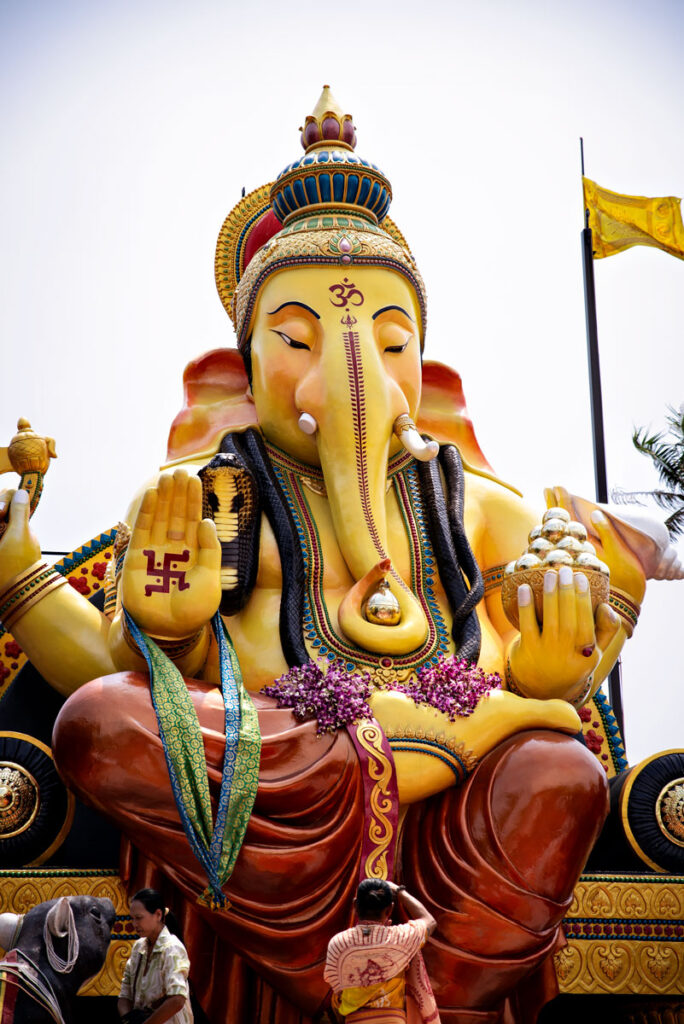

A cacophony of trumpets and weird rhythms. White powder on faces. Flames light up sweaty cheeks. It’s hard to breathe – the air is hot and humid, impregnated with the scent of joss sticks.
Every October, Hindu worshippers gather around the Sri Maha Mariamman Temple on Silom Road. Thais mingle with them – even if they don’t believe in Indian myths and legends, it hardly hurts to pay homage to the goddess Durga. Navaratri is a colorful and mystical festival. Everyone is welcome. Even if we don’t understand the hustle and bustle, we let ourselves be carried away by the singing and dancing crowd.




One morning we are drawn to the quieter Talat Noi district, which means small market. This district is almost as old as Bangkok itself. It is a walk between the past and the present. If you wander through the alleyways without paying attention, you will miss too much. Only with an alert eye can you discover the magic, the spirits inherent in everything.
Portuguese and Chinese lived in Talat Noi. Khmers and other Southeast Asian immigrants. Bangkok’s first port was located here, where goods and people from all over the world arrived in the city.
The Chinese Rong Kueak Shrine lies almost forgotten at the end of a colorfully painted alleyway. In one corner of the temple a man is sewing, fairy lights are flashing in all colors and somewhere the same Chinese song is playing over and over again. A few meters further on, we come across a building in southern Chinese style – an old villa with a large courtyard and pond. Behind it are old and run-down apartment blocks. Back on the main street, we hear the sound of hammering. Handcarts loaded with car parts are pushed past us. Clutches, gearboxes and engine parts are piled up in front of some stores. Side mirrors are lined up on the wall. A group of tourists on bicycles crosses the street and disappears into a side alley.
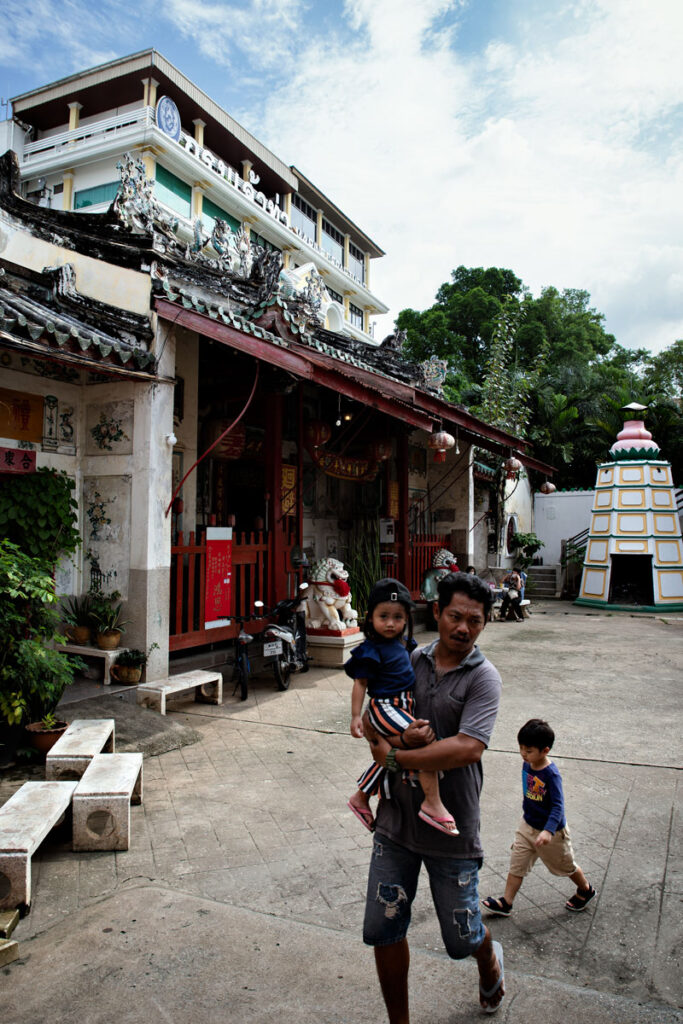





“Look where we worship”, wrote Jim Morrison. The special relationship of the Thais to Buddhism is evident in the temples. Wat Samphran is an extravagant, albeit outdated appearance. Not like all the other temples with their golden chedis, ornate prangs and mystified shrines. In heavy traffic, it takes almost two hours to drive out of the city to the industrial area in which the faded concrete tower, with a dragon clinging to its exterior, rises. Perhaps 40 years ago there were rice fields and water channels, trees and few roads here.
The dragon brings good luck, explains an Australian who is seeking his personal happiness as a monk in this temple. A wreath of flowers – it only costs a little – offered after circling the dragon’s head twice at the top of the tower in front of a Buddha statue could bring the longed-for luck. It is said that most Thais pray for the right lottery numbers. A material dragon that brings material wealth. Is war ultimately just a lack of prosperity? Can love be bought?
It is a nice spectacle for the few tourists in this place. A Thai woman, on the other hand, carries her wreath of flowers up to the Buddha statue, lost in her thoughts. She kneels down and asks for a wish. Perhaps healing for her sick mother. A loving husband. A pay rise. A nicer apartment. She is serious. We enjoy the moment before saying goodbye in the drizzle.





Located on a hill, Wat Saket offers a magnificent view of Bangkok. It is said that the first king of the newly founded capital Bangkok, Rama I, once took a bath and washed his hair here on his return from war.
An idyllic path surrounded by greenery leads up the artificial hill, which is almost 80 meters high. In the darkness, the temple glows golden and stands out like a radiant sun against the skyscrapers of the megacity behind it. We enjoy the magnificent panoramic view of this incredible city. The historic district at our feet, to the south the commercial center along Silom and Sathorn Road. In between, a sea of palaces, temples and residential buildings. An anthill, a bustle so rich in life.

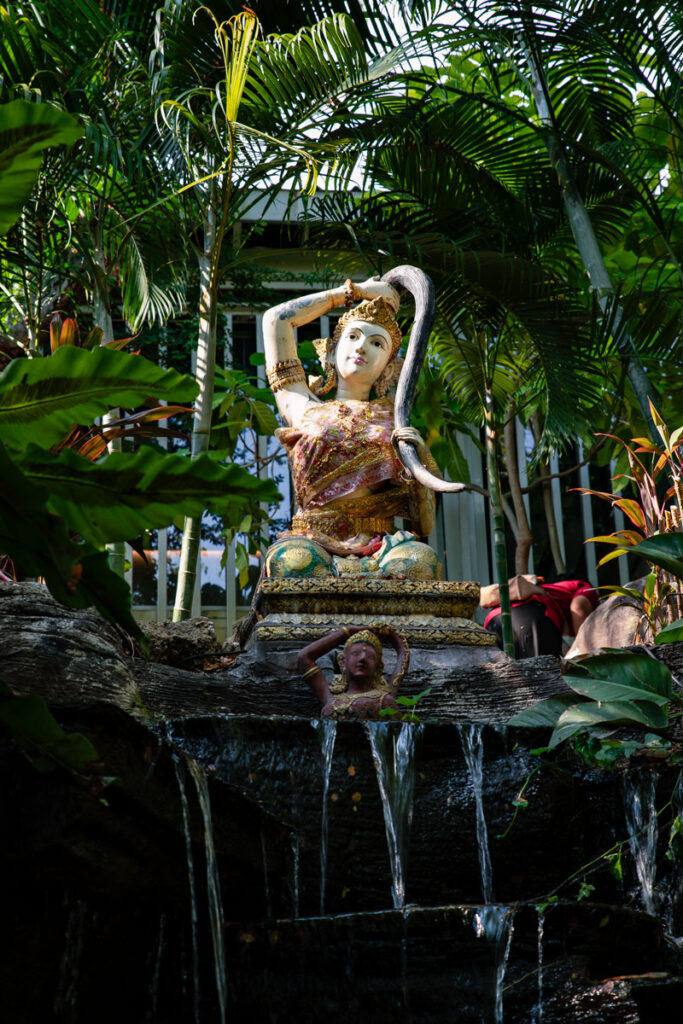
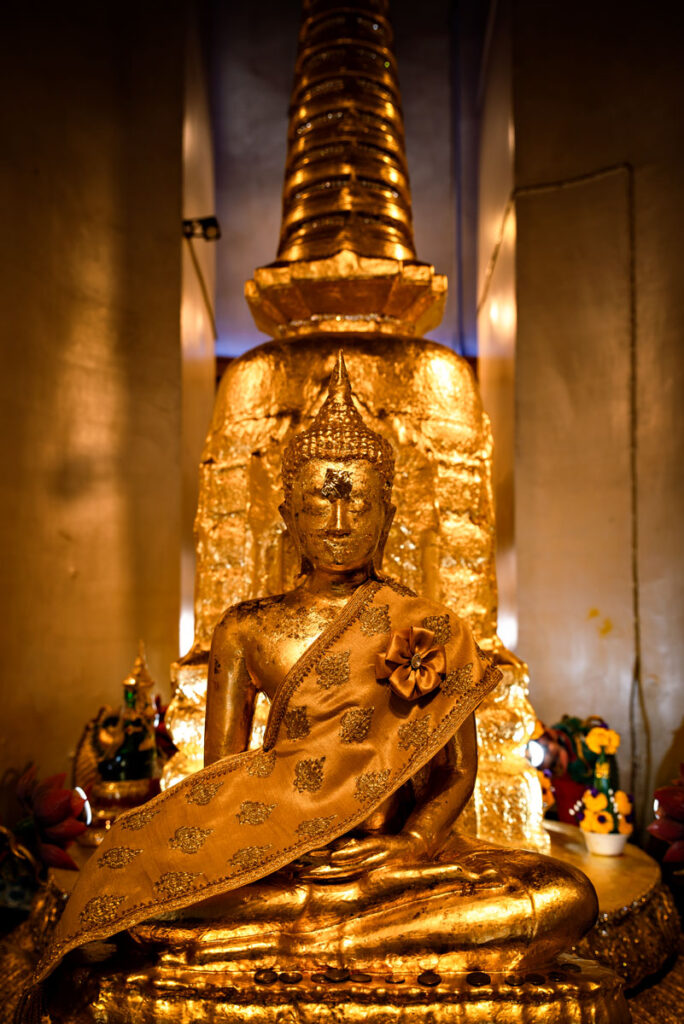


Where there is life, there is also death. Growth and decay are interdependent. And so it is that in times of abundance, people sometimes reach for the stars a little too much.
When the Asian crisis hit Thailand in 1997, construction of the Sathorn Unique Tower came to an abrupt halt. Opposite it is its barely completed twin – the Lebua State Tower. Myths of haunting spirits surround the tower after a backpacker hanged himself on one of the upper floors.
Bangkok’s airplane graveyard – another unofficial landmark. A scurrility that is also surrounded by myths and horror stories. Nobody knows the exact background to the discarded planes. Possibly another shattered dream; an amusement park with food stalls, beer and live music between an old Boeing and Douglas. The money melts away and the dream comes to an end. Lost places, as you find them everywhere, actually always tell the story of a tragedy. Often it is people who die alone or become impoverished, leaving behind a place that falls into ruins.




Bangkok is an organic city that has grown uncontrollably and is nowhere near its end. Slums and luxury malls are just a stone’s throw away from each other. As a tourist, it is easy to ignore this side of the city. It is possible to spend a whole day in the newly built ICON SIAM, between food courts, cinemas and gyms in well-tempered hypocrisy. A river cruise along the Chao Phraya reveals the whole face of Bangkok: crumbling wooden huts, a colonial harbor building, a magnificent temple, then a shopping mall, a palace of consumption. Bars that spring up and disappear just as quickly. What is trendy today is forgotten tomorrow.
The Huai Khwang District is one such example. Currently in vogue among upper-class young people for hip restaurants and Chinese vibes. Instagram’s almighty algorithm dictates what’s popular. While the shopping malls of the last century are still impersonal hulks on the outskirts of Bangkok, architects, urban planners and investors have given the new temples of consumption a different look. More traditional, with a return to Thailand’s history and style, idyllically situated on the Chao Phraya. River City is filled with luxurious handicrafts and works of art by Thai artists. ICON SIAM brings an entire Thai market into its interior with small stores and alleyways.



At some point, night falls. But the sweat on the skin doesn’t dry. The restaurants and sidewalks fill up. Thais shuffle to the nearest 7/11. The metropolis begins to sparkle. Neon lights in the back alleys, colorfully illuminated ships on the mighty Chao Phraya. A drink doesn’t cost much and dispels reality. Long legs and barely clothed Thais – love is for sale. The day is made for temples, the night for sin. Bangkok is full of them.
A cab ride to Khaosan Road, a ride on the BTS to Soi 11. At some point RCA or a rooftop bar. Booming beats, roaring luxury cars in Thong Lo. Strangers meet each other. Street dancers and flower women. Doped up backpackers. A beer tower and Thai curry that’s too spicy. The police look the other way and nothing happens. The clothes are soaked with sweat.
Then, well after midnight, this one moment on the roof of some high-rise building. A breeze comes up – just a gentle breeze, just for a second. Air. Breathe. Clarity in the head. A sea of lights. A metropolis of millions full of fortune-seeking people and doomed spirits. City of devas, capital of the world.
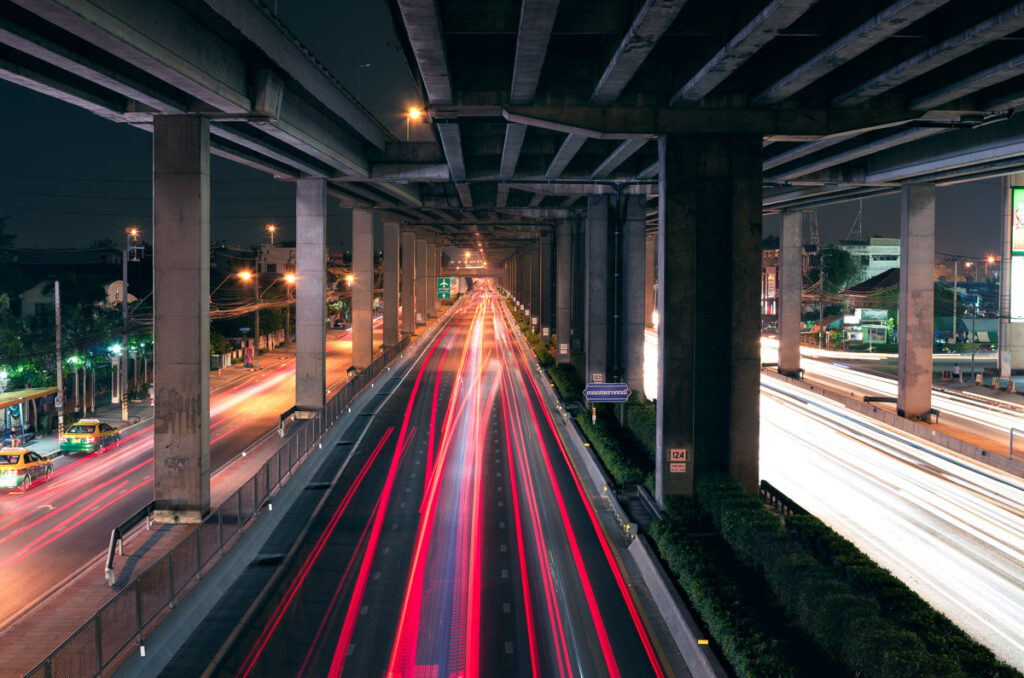

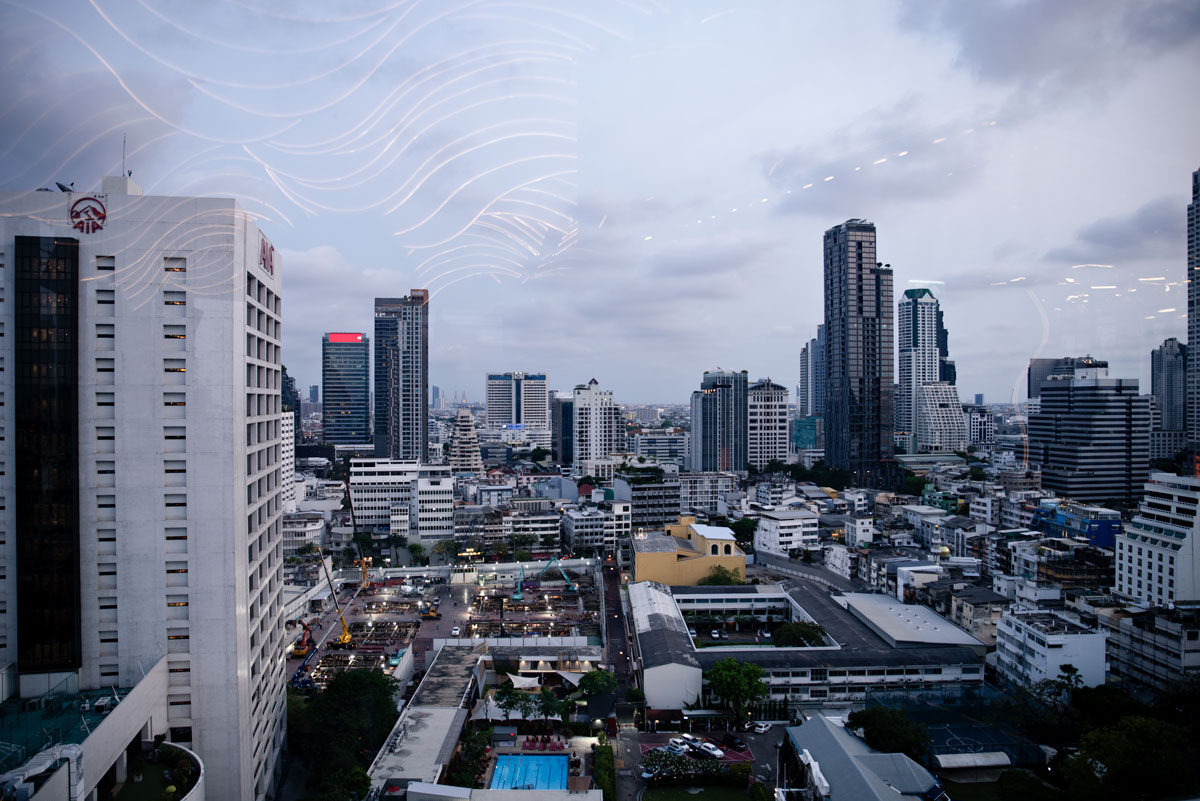



A cold shower the next morning helps with the hangover. You can hate Bangkok if all you see is the smog and the crumbling huts. You can love Bangkok when you hear the sounds in the temples. When you stroll through the tranquil Talat Noi. A relaxed evening on the Chao Phraya, perhaps in the Asiatique, a boat trip past sparkling buildings and glass facades. An evening with good friends and one too many beers. The laughter of an old Thai woman and a good story about Bangkok in the old days. A cooling tuk-tuk ride in the evening breeze and sheer amazement at the sight of the Royal Palace.
Bangkok heals the soul and gives what it has.
Info about our trip
If you are not flying directly to one of the popular vacation islands such as Phuket or Koh Samui, your trip to Thailand will most likely start in Bangkok. You should definitely not miss out on this city. Of course, we write about Bangkok through rose-tinted glasses. Chris has lived in this city and we are here regularly, so we know the city better than anywhere else. Three days will probably be enough for you to see most of the sights. Take it easy on the first day to get used to the time difference and the climate. Then tick off the classic sights with plenty of breaks: Grand Palace, Reclining Buddha and Wat Arun on the first day. Then the JJ Market and up to the King Power Mahanakhon skyscraper to enjoy the great view. In the evening, head to Khaosan Road for a beer or two.
You can also easily extend your Bangkok program to one or two weeks. You’ll find plenty of suggestions on this page 😉
Even though the cost level has risen massively since the coronavirus crisis, Thailand is still quite affordable for Europeans. It should therefore remain a popular backpacker destination. However, don’t forget that many Thais are struggling under the increased costs and that social security is nowhere near comparable to a European country, if it exists at all. So don’t be annoyed if you do get ripped off or simply try not to push the price down too much when bargaining. You’ll be able to get over the money better.
When it comes to hotels, Bangkok is more expensive than rural areas. Expect to pay 30-50 euros for a simple but nice double room. You will find beds in hostels much cheaper. You can eat in street kitchens for around 2 euros per portion, in restaurants you pay between 3-7 euros per dish.
Finding good and cheap food in Bangkok shouldn’t be a problem. Try a delicious noodle soup in a street food kitchen. Buy fruits or a dessert from the numerous street vendors. Have a beer or tea on the roadside with the locals. And of course you can find all kinds of food in restaurants – especially Chinese and Thai cuisine. You can enjoy a very tasty dinner at moderate prices at the Baan Glang Soi restaurant, run by Chris Stepmom.
If you want to really dig in at the buffet and enjoy a great view, head to the Bangkok Sky Restaurant. If you prefer something more dignified (and a lot more expensive), a dinner on the roof of the Lebua State Tower is the right choice for you – but expect to pay a mid-three-figure sum for two people. You don’t necessarily have to eat here, you can also just go up for a cocktail at sunset.
When we are in Bangkok, we have always stayed with Chris’ family or in his stepmother Phong’s hotel.
We can highly recommend Hotel Baan Glang Soi to you as well. Phong is the heart of the soi (street) in which the hotel is located. She herself comes from a simple village in the Isaan region of Thailand and some of the money she earns from the hotel goes back there. The rooms are simple but clean. Unfortunately, Phong suffered greatly from the lack of tourists during the coronavirus pandemic. Now that tourism has returned, she is renovating the hotel bit by bit.
The Foreign Office warns against robberies and fraud. In all the time we spent in Thailand, and Bangkok in particular, nothing at all happened to us. Nevertheless, we also heard the opposite.
What will almost certainly happen to you: People will try to rip you off. Whether it’s cab drivers refusing to turn on the taximeter or asking you to pay four times the price for a tuk-tuk ride. Take it easy. You won’t be able to negotiate the price a Thai would pay anyway.
Otherwise, keep an eye on your valuables and take care of yourself and your money, especially in the party areas. It’s best to leave passports at the hotel and only carry a copy with you.
Thai society is very open-hearted and fond of children. It was not uncommon to see a bunch of Thais (mainly women) standing around our boy. The way Thais treat children is different to what we are used to in Europe. We would never go up to a stranger’s child and want to take it in our arms. This happens all the time in Thailand – people don’t even ask beforehand. You should also be prepared for Thais to take photos of your children – often without being asked. They will quickly whip out their smartphone and take a selfie with the blond, little farang (foreigner). Think about how you want to deal with this – from our Western perspective – cross-border behavior. You won’t always be able to prevent it. Be respectful and smile and let your counterpart know that you would like a little more distance. At the same time, you are even more welcome everywhere with children and we were often given preferential treatment (e.g. in queues).
However, don’t expect extra changing rooms anywhere – the sanitary facilities are often in an inadequate condition anyway. So take wet wipes and disinfectant gel with you. You can buy basic baby supplies in any 7/11 or supermarket. Diapers are not cheap and are often only available in large packs. It’s best to leave the baby carriage/stroller at home. The sidewalks are usually too bad and there are too many pedestrians and cars, especially in Bangkok, so you won’t have much fun with it. The most flexible option is a baby carrier.
Until the coronavirus pandemic, Bangkok was very cheap to reach by plane. A flight with a stopover only costed around 500 euros back then. Now you can easily pay twice as much. Actually all airlines fly to Bangkok, in our opinion the most comfortable flights are with Etihad or Thai Airways.
From Suvarnabhumi Airport to the city you can take a cab or travel – cheaper and just as fast – with the airport shuttle and BTS. The best way to get to Don Mueang Airport is by cab. In the city itself, we recommend the BTS (Bangkok Mass Transit System), which will take you almost everywhere. The best way to get to the Grand Palace and Wat Arun is by boat. Only take a cab if you can’t avoid it. This will save you the discussion about the taximeter and you won’t get stuck in the heavy (!) traffic. In the morning and evening, the streets are so crowded that a journey of a few kilometers can quickly take an hour.
in and between the cities is perfect. You have all the options: Private cab, minibus, intercity bus, scooter, (night) train, plane and ferry. All options are affordable, but of course vary in comfort and speed. You can’t go wrong with any of these means of transportation. Just don’t get ripped off – there are always a few cab drivers or ticket sellers at the tourist spots who will offer you a ride for many times the price. Always buy your tickets at official ticket offices and don’t be fooled if they say the official sales point is closed today.
- If you like crime fiction, try one of John Burdett’s novels – he has written a four-part book series set in Bangkok
- A very good introduction to Thailand’s history in general can be found in Thailand’s Political History: From the 13th Century to Recent Times by B. J. Terwiel
